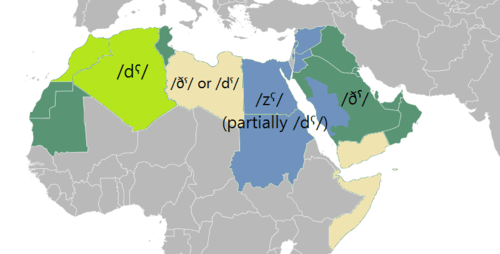Ẓāʾ
Ẓāʾ, or ḏ̣āʾ (ظ), is one of the six letters the Arabic alphabet added to the twenty-two inherited from the Phoenician alphabet (the others being ṯāʾ, ḫāʾ, ḏāl, ḍād, ġayn). In Classical Arabic, it represents a velarized voiced dental fricative [ðˠ], and in Modern Standard Arabic, it can also be a pharyngealized, [ðˤ] voiced dental fricative or voiced alveolar fricative [zˤ]. In name and shape, it is a variant of ṭāʾ. Its numerical value is 900 (see Abjad numerals).
| Arabic alphabet |
|---|
|
Arabic script |
|
| Ẓāʾ | ||||||||||
|---|---|---|---|---|---|---|---|---|---|---|
| ||||||||||
| Phonemic representation | ðˤ~zˤ, dˤ | |||||||||
| Position in alphabet | 27 | |||||||||
| Numerical value | 900 | |||||||||
| Alphabetic derivatives of the Phoenician | ||||||||||
| ||||||||||
| Ẓāʾ | |
|---|---|
| ظ | |
| Usage | |
| Writing system | Arabic script |
| Type | Abjad |
| Language of origin | Arabic language |
| Phonetic usage | ðˤ~zˤ, dˤ |
| History | |
| Development |
|
| Other | |
Ẓāʾ does not change its shape depending on its position in the word:
| Position in word: | Isolated | Final | Medial | Initial |
|---|---|---|---|---|
| Glyph form: (Help) |
ظ | ـظ | ـظـ | ظـ |
Pronunciation

In Classical Arabic, it represents a velarized voiced dental fricative [ðˠ], and in Modern Standard Arabic, it can also be a pharyngealized, [ðˤ] voiced dental fricative or voiced alveolar fricative [zˤ].
In most Arabic vernaculars ظ ẓāʾ and ض ḍād have been merged quite early.[1] The outcome depends on the dialect. In those varieties (such as Egyptian, Levantine and Hejazi), where the dental fricatives /θ/, /ð/ are merged with the dental stops /t/, /d/, ẓāʾ is pronounced /dˤ/ or /zˤ/ depending on the word; e.g. ظِل is pronounced /dˤilː/ but ظاهِر is pronounced /zˤaːhir/, In loanwords from Classical Arabic ẓāʾ is often /zˤ/, e.g. Egyptian ʿaẓīm (< Classical عظيم ʿaḏ̣īm) "great".[1][2][3]
In the varieties (such as Bedouin and Iraqi), where the dental fricatives are preserved, both ḍād and ẓāʾ are pronounced /ðˤ/.[1][2][4][5] However, there are dialects in South Arabia and in Mauritania where both the letters are kept different but not consistently.[1]
A "de-emphaticized" pronunciation of both letters in the form of the plain /z/ entered into other non-Arabic languages such as Persian, Urdu, Turkish.[1] However, there do exist Arabic borrowings into Ibero-Romance languages as well as Hausa and Malay, where ḍād and ẓāʾ are differentiated.[1]
Statistics
Ẓāʾ is the rarest phoneme of the Arabic language. Out of 2,967 triliteral roots listed by Hans Wehr in his 1952 dictionary, only 42 (1.4%) contain ظ.[6]
In other Semitic languages
In some reconstructions of Proto-Semitic phonology, there is an emphatic interdental fricative, ṱ ([θˤ] or [ðˤ]), featuring as the direct ancestor of Arabic ẓāʾ, while it merged with ṣ in most other Semitic languages, although the South Arabian alphabet retained a symbol for ẓ.
Writing in the Hebrew alphabet
When representing this sound in transliteration of Arabic into Hebrew, it is written as ט׳.
Character encodings
| Preview | ظ | |
|---|---|---|
| Unicode name | ARABIC LETTER ZAH | |
| Encodings | decimal | hex |
| Unicode | 1592 | U+0638 |
| UTF-8 | 216 184 | D8 B8 |
| Numeric character reference | ظ | ظ |
See also
References
- Versteegh, Kees (1999). "Loanwords from Arabic and the merger of ḍ/ḏ̣". In Arazi, Albert; Sadan, Joseph; Wasserstein, David J. (eds.). Compilation and Creation in Adab and Luġa: Studies in Memory of Naphtali Kinberg (1948–1997). pp. 273–286.
- Versteegh, Kees (2000). "Treatise on the pronunciation of the ḍād". In Kinberg, Leah; Versteegh, Kees (eds.). Studies in the Linguistic Structure of Classical Arabic. Brill. pp. 197–199. ISBN 9004117652.
- Retsö, Jan (2012). "Classical Arabic". In Weninger, Stefan (ed.). The Semitic Languages: An International Handbook. Walter de Gruyter. pp. 785–786. ISBN 978-3-11-025158-6.
- Ferguson, Charles (1959). "The Arabic koine". Language. 35 (4): 630. doi:10.2307/410601.
- Ferguson, Charles Albert (1997) [1959]. "The Arabic koine". In Belnap, R. Kirk; Haeri, Niloofar (eds.). Structuralist studies in Arabic linguistics: Charles A. Ferguson's papers, 1954–1994. Brill. pp. 67–68. ISBN 9004105115.
- Wehr, Hans (1952). Arabisches Wörterbuch für die Schriftsprache der Gegenwart.